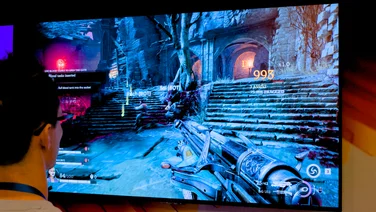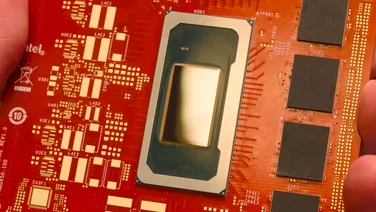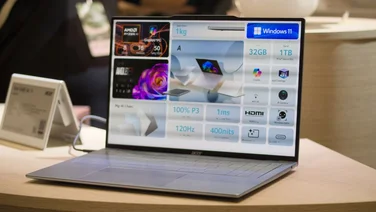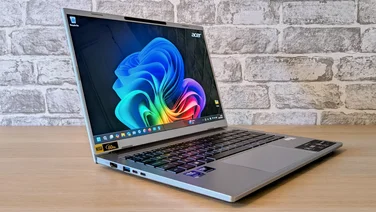To help us provide you with free impartial advice, we may earn a commission if you buy through links on our site. Learn more

Professional content creation work takes a lot of processing power, and if you’re modelling 3D, you need plenty of graphics grunt too. This is why traditionally you would not opt for a notebook, and instead do your work on a giant floor-standing workstation, usually available only in black, reminiscent of something out of Stanley Kubrick’s 2001: A Space Odyssey. But there are laptops that can deliver the level of performance required for professional work, and they don’t even have to be bespoke workstation portables either.
The key ingredients of a content creation workstation are processing power, graphics power, fast primary storage for software loading, plenty of asset capacity, and a great screen with dependable colour fidelity. All these can be features of a laptop. They’re also the features to look for in a gaming notebook, which is why one of these can be a sensible choice for getting some serious work done on the move, with the added bonus of being great for out-of-hours downtime at home.
First, you want a powerful CPU. Intel’s latest Coffee Lake processors have made a significant step up on core count. The Core i7-8750H and i7-8850H both boast six cores instead of the four in the previous top models from the Kaby Lake generation. Despite having more cores, these processors also have faster top Turbo Boost modes, with the 8750H running at up to 4.1GHz and the 8850H up to 4.3GHz. This is great for single-threaded apps, which 3D modelling software and games still tend to be. But they also have six cores that tasks like 3D rendering and video encoding can benefit from.
Best of all, these are still 45W processors, like their predecessors, so continue to offer a decent battery life from a portable device. Workstations also need plenty of memory, because professional software will generally require a lot of dynamic RAM to handle high-resolution images, 4K video footage and 3D models with large texture sets. So 16GB will be recommended, and 32GB even better.

For 3D content creation, fast graphics is a must, along with plenty of frame buffer memory. A gaming laptop is likely to be well endowed in this area too. The 10-series GeForce GTX GPUs from NVIDIA are very potent, and available in mobile versions. However, one thing you won’t get with a gaming laptop that doesn’t use professional graphics is ISV certification and the support that goes with it.
But whilst there are some applications that are really not very well optimised for non-professional graphics accelerators, most are just fine, and the all-important Autodesk 3ds Max and Maya run well on consumer-grade graphics. Also, any software that benefits from CUDA GPU acceleration, such as Adobe’s video editing applications, will get just as much benefit from a GeForce as a Quadro. Finally, content creators working on VR projects often require consumer-grade graphics to view the content they are creating.
The next piece of the puzzle is storage. Most professional content creation activities require huge amounts of space, so a desktop workstation will typically have more than one drive. This will often consist of a fast SSD for the operating system and applications, plus a larger conventional hard or RAID as a content and asset repository. Laptops, being short on space, won’t have the same level of ability to provide loads of additional disks. But most beyond the Ultrabook form factor will provide two or three drive slots. Now that the M.2 format has become mainstream, and optical drives no longer a requirement, even a fairly thin laptop can provide two drives.
The latest laptops tend to offer two M.2 slots, which could be populated with a faster NVMe drive for operating system and apps and a cheaper, higher-capacity SATA drive for general storage. Or two NVMe drives could be configured using RAID for fault tolerance or improved performance, depending on which is the priority for your usage scenario. Editing really large images might benefit from RAID 0 striping, for example, so that a non-RAM scratch disk can be accessed as fast as possible.
If you’re creating content on the move, the ability to attach external storage peripherals with the fastest connection possible is also a necessity. Having an SD card reader built in makes dealing with still images or video footage captured to this memory type much more seamless. But if you are working as a digital imaging technician with an external drive full of 4K footage, having a USB Type 3.1 Gen 2 Type C and/or Thunderbolt 3 port available will be essential.
The final requirement in a notebook for professional use is a good screen, and here laptops can fare very well, too. Of course, you can’t expect a 34in widescreen on a device you need to carry around with you in a regular shoulder bag or backpack. But you can now get some excellent Full HD or even 4K IPS displays on laptops, often with calibrated colour and excellent gamut ratings. A USB Type-C port also opens the possibility of connecting to external 4K displays, including portable models.

Whilst there are some great mobile workstations available with Xeon processors and professional graphics, you pay a lot for the privilege, and a good gaming laptop can give you most of the benefit for a lot less – plus great gaming when you’re not working.
For example, Gigabyte’s AERO 15X costs £2,199 with a 15.6in Full HD screen, and £2,399 for the 4K display version. Both are high-quality IPS panels. The Full HD option sports a game-friendly 144Hz refresh and X-Rite Pantone certification, whilst the 4K option boasts 100% Adobe RGB gamut, along with X-Rite Pantone certification. A six-core Intel Core i7-8750H processor running at up to 4.1GHz is partnered with 16GB of 2666MHz DDR4 memory, plus an option for 32GB.
There’s 8GB Nvidia GeForce GTX 1070 graphics, which will have plenty of GPU power and frame buffer for most applications. The main storage is a healthily-sized 512GB NVMe M.2 SSD, but there’s a second M.2 slot for extra storage if required. A high-speed UHS-II SD card reader is available offering up to 312MB/sec bandwidth, plus USB 3.1 Gen 2 in both Type-A and Type-C forms, with the latter doubling as 40Gbits/sec Thunderbolt 3.
Yet all this comes in a package weighing just 2kg and measuring 18.9mm thick. There’s a 94.24Wh battery, too, so you can squeeze in quite a few hours of work while on the road. And when there is mains power available, you can enjoy desktop-like professional content creation and gaming performance for as long as you like. So, you really could have the best of many worlds – top-class entertainment, professional grunt, and the ability to take your workstation wherever needed. The new Gigabyte AERO laptops can deliver everything creative professionals and gamers need in a sleek and light package.





